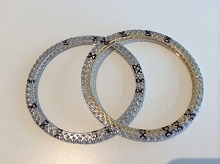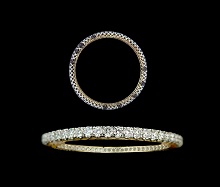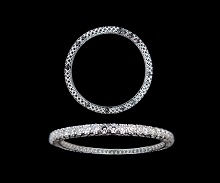Undisclosed Synthetic Diamonds 'Shift' To Finished Set Jewelry
September 18, 14
Let’s start with a riddle. Look carefully at the beautiful diamond bracelets containing 20 to 30 pointers at the bottom of the page. Each bangle contains a total weight of around 10 to 15 carats. They are beautiful high-collection goods having a wholesale price of some $20,000 per piece. Now take a closer look at a few stones within each bracelet that the International Gemological Institute (IGI) laboratory in Mumbai has darkened with black ink. My question is: what do these black marked diamonds represent? What makes them so “special” as to be marked?
No, these diamonds don’t represent undisclosed synthetics! Wrong answer! These marked diamonds are the ONLY diamonds in these three bracelets that are, in fact, natural! The high-end jeweler in Mumbai, who paid full price for three diamond bracelets almost received a heart attack upon learning that he had been “taken to the cleaners” (to use a term I am quite fond of as of late). This incident happened just a few weeks ago. The IGI has since returned the bracelets to the submitter.
We observed some media silence to enable the jeweler to “work things out” with the middlemen who sold the bracelets to him. In any case, the jeweler wouldn’t reveal details...
At this time, no real interest is served by naming companies and people. The relevant GJEPC diamond committee will know how to find the IGI lab – in case it wants to follow up. It should. IGI Worldwide CEO Roland Lorié, contacted by DIB, confirmed the story. So did the IGI India Managing Director Tehmasp Printer.
A Shift from Loose Diamonds to Diamond-Set Jewelry
The myriad of revelations on the undisclosed selling of gem-quality synthetics, the higher degree of general industry awareness, combined with the developments of more (and more affordable) detection devices have both positive and negative spillover effects. Laboratories note a reduction in discoveries of undisclosed synthetics but, at the same time, are witnessing a growing trend of undisclosed synthetics in diamond-set jewelry.
This poses an entirely different set of challenges to the diamond business.
We are aware of a huge amount sales of synthetics to the Arab world via Abu Dhabi. Discovery there will not impact global trade confidence, though I wouldn’t want to be in the seller’s shoes. However, the United States is a different story. If we look at our main market, we know that, measured in polished wholesale prices (PWP), the value of the diamonds in U.S. diamond jewelry sales is about $8-$9 billion.
What is not often sufficiently appreciated is that two-thirds of U.S. diamond jewelry consumption consists of diamonds that were already set in jewelry overseas and that were imported into the United States not as loose but as jewelry-set stones.
America Exports More Polished Carats than It Imports
The huge values of polished diamond imports into the United States are misleading: the United States is no less a transit center than places such as Dubai, Switzerland or some other countries. In 2012, for example, the United States imported $19.6 billion worth of polished diamonds – but in the very same year, it exported $16.6 billion worth. Thus there was some $3 billion “available” for the domestic diamond jewelry retail business. However, as total domestic jewelry sales contained $8-$9 billion of polished (PWP), simple arithmetic shows that $5-$6 billion of retail sales was imported as finished diamond-set jewelry. If we look at 2013, we see the very same consistent and time-honored pattern: polished diamond imports were $22.8 billion, with exports of $19.1 billion of loose diamonds.
McKinsey: Recycling Five Million carats in 2013
For example, in a fascinating report titled “Perspectives on the Diamond Industry,” which was published this week by McKinsey (“Basic Materials” series), recycling is seen as a major factor in the supply of diamonds. However, the report hedges by concluding that “even under the most aggressive assumptions, recycling will likely only represent about 1/3 of supply by 2025.” For 2013 and 2014, McKinsey’s graphs show that recycled diamonds contributed 5 million carats to the diamond value chain – something which might explain why the U.S. has become a net exporter of polished diamonds.
McKinsey also has synthetics on its radar screen. “Synthetic gem companies and the technology they use are becoming increasingly sophisticated. If synthetic stones leak into the diamond value chain without being properly labelled as synthetic, they may pose a risk to the industry by undermining consumer confidence in the authenticity of what they are buying. However, detection technology used to identify synthetics has, so far, kept up with the technology used to produce them.”
In its “The Diamond Insight Report,” which was also published this week, De Beers forcefully reiterates these concerns. “Any damage to consumers’ confidence in their natural diamond purchases could have consequences for the whole industry. Undisclosed synthetic diamonds present exactly such a risk. The inability to distinguish confidently (and therefore disclose) synthetics from natural gem diamonds could lead to a collapse of consumer and trade confidence in the value-perception of, and desire for, natural gem diamonds. This may ultimately lead to consumers abandoning the category [of diamond jewelry], temporarily or permanently,” says the report.
It stresses that to “minimize the risks to consumer confidence resulting from deliberate or inadvertent undisclosed synthetics, De Beers has invested nearly $65 million in research over the last 30 years (in today’s value) to develop sophisticated technology.”
Nightmare Scenario: “Extreme Shocks to Demand”
McKinsey provides various possible future scenarios that might change all of its rather optimistic views on the industry’s future. “If consumers lost faith in diamonds, either because they lost faith in the natural diamond supply chain, for example, through an influx of synthetic diamonds, or if diamonds lost their emotional equity, a reputation-driven demand shock might occur. This could have effects similar to those in the fur industry in the 1990s, following extensive negative exposure in the media.”
“Similarly,” warns McKinsey, “a policy-driven demand shock might occur if policy makers in one of the big growth markets intervened to restrain or even ban the purchase of diamonds.”
What both McKinsey and De Beers ought to realize is that the greater detection sophistication goes hand in hand with greater sophistication by criminals to meet their unsatisfiable appetite for greed and a total lack of concern for the future of the diamond industry.
That gets us back to the subject of recycled diamonds and the diamond export data of the United States. Interviews with diamantaires who buy diamond jewelry from pawnshops, inventories from store closures, and other sources have found that stones which were said to be diamonds occasionally turned out to be either a simulant (cubic zirconia, moissanites, etc.) or synthetics!
The Crooks are Getting Increasingly Sophisticated
DIB has documents and testimonies that increasingly point to cash transactions (to avoid transparency in the chain of custody) where synthetics are purchased to be mixed already at the level of jewelry manufacturing. Total imports of jewelry into the United States (combining stone-set and other jewelry) total $7.5 billion (in 2013). Out of this, India supplies $1.52 billion, China $1.3 billion (with an additional $300 million from Hong Kong), Thailand $1.15 billion, while the “traditional” suppliers to America such as Italy and Mexico are down to respectively $590 million and $290 million. The diamond jewelry by-passes the regular diamond trade. What do we know about this jewelry?
The Managing Director of IGI India, Tehmasp Printer, observes that “virtually all of the American jewelry majors import finished diamond-set jewelry from India. They ought to make far greater efforts to avoid situations in which they discover the undisclosed synthetics only at the retail level – if discovered at all. The checking should take place at the exit gate of the jewelry manufacturing plant. The plant should be the entity that giving the guarantees that all contents are natural diamonds.” Printer’s suggestion is, of course, not without some self-interest, but his point is valid.
[It poses, however, some other “practical” problems: there is evidence (also revealed in court cases) that some jewelers want to purchase the jewelry from a local diamond and diamond jewelry importing company that may under-declare the jewelry’s true value to avoid the import duties. Then, the finished jewelry is purchased locally at full value. Reducing import duties on diamond-set jewelry to zero might do wonders for transparency and efficiency in the supply chain. This will be discussed in forthcoming articles.]
DIB has written before about what we dubbed hypothetically as the “Oprah Winfrey scenario,” where the famous talk-show host, producer and actress, holds up a beautiful piece of diamond jewelry (Optah is known to be a collector of great pieces) while bursting out in tears sharing with her audience the discovery “that these valuable stones turned out to be synthetic junk.” McKinsey people take note: this will get you straight into your demand-driven shock scenario.
The Problem is in the Jewelry
Prominent jewelers are aware of their vulnerability when it comes to the pieces they sell. DIB is aware of a lengthy court action related to undisclosed synthetics in imported jewelry. There are other instances known (to me and to others), though we have yet to see a “general recall” of such jewelry. The jewelers don’t really know how to communicate these “accidents” to customers.
Except for one ongoing U.S. police investigation, we are not really aware of any criminal prosecution. Discoveries are generally settled between seller and buyer. Suzan Flamm, Senior Counsel at the Jewelers Vigilance Committee, has recently publicly reiterated that undisclosed synthetics selling is a violation of various U.S. laws, including breach of contract, breach of warranty, deceptive trade practices (U.S. Lanham Act) and, under certain circumstances, may also be a criminal violation when there is a clear intent to defraud.
The Mumbai bracelet event is, in a way, “a breach of contract,” as “buyer promises to pay agreed price and seller promises to sell diamonds. If the word ‘diamonds’ is unqualified, that means natural diamonds. Thus the seller breaches contract if he/she delivers synthetic diamonds,” explained Advocate Suzan Flamm (at a recent CIBJO meeting).
If caught selling undisclosed synthetics, it is not an acceptable defense for the seller to then claim that “he didn’t know that diamonds are synthetic,” she warned. One should have known.
Who Will Find Out?
It is wishful thinking to claim – as some do – that the “epidemic” occurrence of undisclosed synthetics is behind us. Those who were criminally cheating before haven’t suddenly retired – they have just changed methods; they are getting better. Pressures on transparent chains of custody have increased the use of cash – no tracing. The chances for discovery have, however, greatly diminished due to the shift to setting synthetics in finished jewelry. Is a retailer selling a diamond bracelet really going to go through the costly exercise of taking the piece apart to check the individual stones?
IGI’s Roland Lorié explains that analyzing the diamonds set in finished jewelry items is a complex exercise. “Without disassembling heirlooms or complex pieces, we have developed techniques for providing expert and impartial analysis of a jewelry item's precious stones, estimating approximately total carat weight, and giving split opinions on color and clarity.”
The IGI has special jewelry certificates (see picture), and issues well over 100,000 such certificates a year, just in India.
In diamond-set jewelry pieces containing dozens of diamonds or more, only a few stones are randomly checked. That’s an additional reason why verification is not foolproof. However, discoveries of diamond jewelry in which well over 80 percent of the diamonds were undisclosed synthetics is considered quite a rare event – rare enough to devote an editorial to it.
Let’s hope that these discoveries will never become the “norm of the future” that are no longer worth mentioning… Or has that highly undesirable future already arrived?


